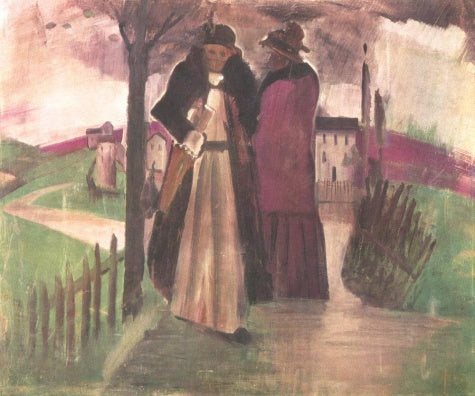Description
The work "After the storm" (1934) by Istvan Farkas is a fascinating representation of the calm and desolation that follows a cataclysmic event. The painting stands out not only for its space-time composition, but also because of the mastery with which Farkas handles colors, lights and shadows. This canvas invites us to immerse ourselves in a deep reflection on the moments of stillness that follow agitation, and how nature and the human being remembered in an almost poetic way.
In the center of the composition, an architectural structure is observed that seems to have resisted the storm. This building, which reminds us of a solid European building of the early twentieth century, serves as the main axis around which the visual narrative develops. Around it, the landscape shows the effects of the storm: trees stripped of its foliage and scattered rubble add a sense of loss and fragility. The symmetry of the building in contrast to the asymmetry of the landscape helps to create a visually intriguing composition. This contrast game is usual in Farkas's work, who has always sought to highlight the duality between order and chaos.
Color is another of the elements that Farkas uses with a mastery in this work. Gray and brown tones predominate, which evoke a humid and gloomy atmosphere after the storm. However, some touches of more vivid colors, such as the blue of the sky that begins to clear, tell us about a resurgistic hope, a renewed clarity after the tumult. Color management in this work is subtle but effective, and contributes greatly to the emotional state that the painting transmits.
If we stop in the details, we notice the absence of human figures in the foreground, which enhances the feeling of loneliness and desolation. However, the presence of a lonely human figure in the distance adds an essential narrative element, perhaps suggesting the return to everyday life after disaster. This figure can be interpreted as a symbol of the human being resurfaceing from adversities, a constant in Farkas's art.
Istvan Farkas, Hungarian by birth but influenced by the artistic currents of Paris, had a life marked by instability and exile. His personal experience with war and Jewish persecution during World War II permeates his works of a tragic and melancholic feeling. "After the storm" is inscribed in this context, being a painting that tells us about resistance and renewal, recurring themes in Farkas's work.
Although "after the storm" is a work in itself and captivating, it finds parallel in other works of contemporary artists who also sought to capture the essence of the moment after a catastrophe. Painters such as Giorgio de Chirico with their metaphysical landscapes or Edward Hopper with their shared solitude scenes, produce a tacit dialogue with Farkas's work, while all of them try to capture that disturbing stillness that follows the climax of the storm.
In summary, "after the storm" by Istvan Farkas is not only a masterpiece from the technical and compositional point of view, but also a deep testimony of human resilience. The painting is erected as a visual meditation on fragility and strength, about adversity and hope, capturing in its form and color the delicate balance between destruction and rebirth.
KUADROS ©, a famous paint on your wall.
Hand-made oil painting reproductions, with the quality of professional artists and the distinctive seal of KUADROS ©.
Art reproduction service with satisfaction guarantee. If you are not completely satisfied with the replica of your painting, we refund your money 100%.

